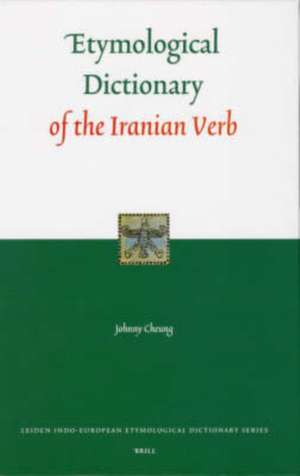Etymological Dictionary of the Iranian Verb: Leiden Indo-European Etymological Dictionary Series, cartea 2
Autor Johnny Cheungen Limba Engleză Hardback – 12 dec 2006
The Iranian group within the Indo-European language family consists of languages that were and are still spoken in Western and Central Asia, among which Persian, Balochi, Kurdish, Pashto, Shughni and Ossetic are the best known today, and Avestan, Old and Middle Persian, Parthian, Bactrian, Khotanese, Sogdian and Choresmian in the past. This work aims to bridge the gap in knowledge that exists between Indo-Europeanists and scholars of Iranian languages with regard to each other's fields.
Preț: 950.33 lei
Preț vechi: 1158.94 lei
-18% Nou
Puncte Express: 1425
Preț estimativ în valută:
181.85€ • 190.34$ • 151.35£
181.85€ • 190.34$ • 151.35£
Carte indisponibilă temporar
Doresc să fiu notificat când acest titlu va fi disponibil:
Se trimite...
Preluare comenzi: 021 569.72.76
Specificații
ISBN-13: 9789004154964
ISBN-10: 9004154965
Pagini: 600
Dimensiuni: 155 x 235 x 41 mm
Greutate: 1.26 kg
Ediția:Bilingual
Editura: Brill
Colecția Brill
Seria Leiden Indo-European Etymological Dictionary Series
ISBN-10: 9004154965
Pagini: 600
Dimensiuni: 155 x 235 x 41 mm
Greutate: 1.26 kg
Ediția:Bilingual
Editura: Brill
Colecția Brill
Seria Leiden Indo-European Etymological Dictionary Series
Public țintă
All those interested in Indo-European and (Indo-)Iranian philologyNotă biografică
Johnny Cheung, Ph.D. (2000) in Comparative Linguistics, Leiden University, is research assistant at SOAS, London, and research fellow at Clare Hall, Cambridge. He has published extensively on Iranian linguistics, notably Studies in the Historical Development of the Ossetic Vocalism (2002).
Recenzii
"C'est un très beau travail et je me réjouis qu'il soit enfin disponible dans forme de livre. Il est en tout point digne des Leiden Indo-European Etymological Series (IEED)", Prof. Jean Kellens
Chaire de Langues et religions indo-irannienes
Collège de France
'This is a very valuable guide to the Iranian verb, both for the book's uniqueness in filling a lacuna in the field , and for its intrinsic excellence. It should be of interest for not only Iranists, but also for Indo-Europeanists. The etyma are supported by a great wealth of material from diverse languages, with many interesting analyses, and rich, up-to-date, bibliographical support. While the book, as is inevitable with a work of this sort and scope , may occasionally invite variant views (and some additional entries), the overall comprehensiveness, reliability and utility of this very erudite opus is without question. Indeed, Johnny Cheung has given us a tome which is now indispensable for both advanced scholars and students.'
Professor Martin Schwartz, Iranian Studies, Near Eastern Deparment, University of California at Berkeley
Chaire de Langues et religions indo-irannienes
Collège de France
'This is a very valuable guide to the Iranian verb, both for the book's uniqueness in filling a lacuna in the field , and for its intrinsic excellence. It should be of interest for not only Iranists, but also for Indo-Europeanists. The etyma are supported by a great wealth of material from diverse languages, with many interesting analyses, and rich, up-to-date, bibliographical support. While the book, as is inevitable with a work of this sort and scope , may occasionally invite variant views (and some additional entries), the overall comprehensiveness, reliability and utility of this very erudite opus is without question. Indeed, Johnny Cheung has given us a tome which is now indispensable for both advanced scholars and students.'
Professor Martin Schwartz, Iranian Studies, Near Eastern Deparment, University of California at Berkeley







